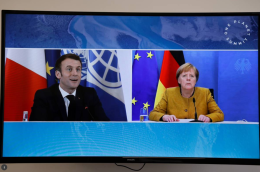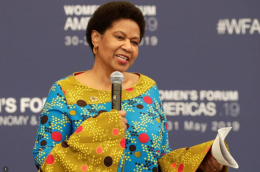Women's Leadership
Main navigation
By Emma Batha
LONDON, Feb 1 (Thomson Reuters Foundation) - Boosting the number of female leaders and government ministers will help build a stronger post-pandemic world, the head of U.N. Women, Phumzile Mlambo-Ngcuka, said on Monday as data showed women may wait 130 years to see equality at the top.
Here are some key facts about women in leadership positions:
- There are 22 countries with elected female heads of state or government. Recent additions to the list include Peru, Lithuania and Moldova.*
- On Jan. 25, Estonia became the only country with a female president and female prime minister.
- A total of 119 countries have never had a woman leader.
- At the current rate of progress, gender parity at the highest positions of power will not be reached for 130 years.
- Parity will not be achieved in national legislative bodies before 2063 and in ministerial positions before 2077.
Click here to read the full article published by Reuters on 1 February 2021.
By Emma Batha
LONDON, Feb 1 (Thomson Reuters Foundation) - Countries must put more women into leadership roles to build a stronger post-pandemic world, a top U.N. official said on Monday as data showed women could be waiting more than a century to see equality at the highest political echelons.
Phumzile Mlambo-Ngcuka, who made history as South Africa's first female deputy president in 2005, said gender-balanced cabinets made better decisions not just for women, but for society as a whole.
Global progress on getting more women into top roles is frustratingly slow, she told the Thomson Reuters Foundation.
But she believes Kamala Harris's appointment as the first female U.S. vice president will make other countries take note and spur more women to consider running for office.
"It does help if a big country breaks the mould. It pushes other countries forward," she said.
Mlambo-Ngcuka said Harris, who is of Indian and Jamaican heritage, was a particularly important role model for young women of colour.
"They now have someone who looks like them, who they can identify with," she said, adding that she had witnessed how her own appointment in 2005 had encouraged the ambitions of a younger generation.
"It was such a fulfilling feeling to hear young women (saying) 'Wow, this is on the table. I can also go for this'," Mlambo-Ngcuka said.
Only 22 countries have an elected woman head of state or government, while 119 nations have never had a woman leader, according to U.N. Women, which said gender parity would not be achieved for another 130 years at the current rate of progress.
Click here to read the full article published by Reuters on 1 February 2021.
Estonia’s new two-party coalition government has been sworn in with the first female prime minister since the Baltic nation regained independence in 1991.
The 15-member cabinet of Kaja Kallas, a 43-year-old lawyer and a former MEP, was approved in the 101-seat Riigikogu legislature, after being appointed by President Kersti Kaljulaid.
The centre-right Reform party, chaired by Kallas, and the left-leaning Centre party, Estonia’s two biggest political parties, secured a deal on Sunday to form a government, replacing the previous cabinet led by Centre leader and former prime minister Jüri Ratas, that collapsed this month due to an alleged corruption scandal.
Both parties have seven ministerial portfolios in the cabinet in addition to Kallas’s prime minister post. The government musters a comfortable majority in the parliament.
Click here to read the full article published by The Guardian on 26 January 2021.
On January 14, 2021, President Rodrigo Duterte announced that his daughter, the current mayor of Davao, has no plans to run for president in the 2022 elections, saying in a speech: "My daughter, inuudyok naman nila, sabi ko, my daughter is not running. I told Inday not to run kasi naawa ako sa dadaanan niya na dinaanan ko. Hindi ito pambabae...The emotional setup of a woman and a man is totally different. Maging g*go ka dito. That's the sad story." This is not the first time the president has implied that women are somehow inferior—his late-night speeches and annual State Of The Nation Addresses are proof of that.
In September 2020, Council on Foreign Relations' Women's Power Index revealed that 21 out of 193 countries have women as heads of their state or government. As the COVID-19 pandemic spread worldwide, it became apparent that when it comes to their respective countries' pandemic response, it seems like female world leaders are doing much better and have lower COVID-19 cases compared to their male counterparts! An analysis by the Centre for Economic Policy Research and the World Economic Forum, as reported by The Guardian, suggests that "the difference is real and may be explained by the 'proactive and coordinated policy responses' adopted by female leaders."
So... here are just a few amazing women who have led their country's COVID-19 response and recovery—proof that women can (and SHOULD be) presidents, prime ministers, and world leaders.
Click here to read the full article published by Cosmopolitan on 15 January 2021.
By Helen Clark
After a year of pandemic-induced turmoil in which women political leaders outperformed their male counterparts, the case for greater gender parity in leadership roles should be obvious. Nonetheless, a new international survey shows that there has been little progress in changing public attitudes.
NEW YORK – As governments around the world seek to “build back better” from the pandemic, addressing women’s under-representation in political and corporate leadership must be at the top of the agenda. We simply cannot achieve the resilient, inclusive, and susta inable societies that we need if the current gap between women and men persists.
Closing the gap would yield massive economic benefits. The World Bank estimates that bringing women’s lifetime earnings up to the same level as those of men would translate into a “gender dividend” of $172 trillion in global human-capital wealth. We already know that companies with higher levels of both gender and ethnic diversity tend to deliver better economic performance.
Nonetheless, new research from the Reykjavík Index for Leadership shows a lack of progress in public perceptions of women’s suitability for leadership roles in comparison to the way that men in such roles are perceived. An Index score of 100 indicates that there is complete agreement that men and women are equally suitable for leadership. That score has remained stagnant across all countries surveyed for the last three years, averaging 73.
Click here to read the full article published by Project Syndicate on 8 January 2021.
This report contains an examination of global trends, persistent barriers and opportunities with regard to women’s full and effective participation and decision-making in public life, as well as the elimination of violence, for achieving gender equality and the empowerment of all women and girls. Progress made in women’s representation at different levels, mainly through legislated gender quotas, and the impact of women’s participation in decision-making and civil society, are acknowledged in the report.
Systemic challenges, especially the increasing levels of violence perpetrated against women in public life and certain enduring harmful norms, require urgent attention, as do specific challenges encountered by marginalized women who face multiple and intersecting forms of discrimination. States can facilitate a more inclusive and enabling environment in which all women could participate in public life through more ambitious targets, increased political will, sustainable financing and gender-responsive institutional arrangements.
The coronavirus disease (COVID-19) pandemic has compounded challenges to decision-making, and, while women have rarely been included in decision-making on COVID-19 response efforts in equal numbers to men, in several countries where they have been in leadership positions, the response to the pandemic has been particularly effective. The report concludes with recommendations for consideration by the Commission on the Status of Women.
Click here to access the report.





